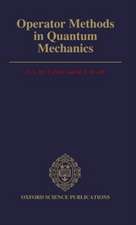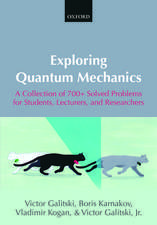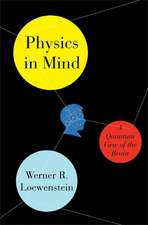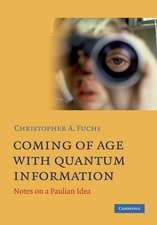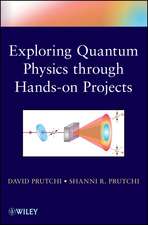Quantum Mechanics: Graduate Texts in Contemporary Physics
Autor K.T. Hechten Limba Engleză Hardback – 19 mai 2000
| Toate formatele și edițiile | Preț | Express |
|---|---|---|
| Paperback (1) | 664.29 lei 6-8 săpt. | |
| Springer – 14 oct 2012 | 664.29 lei 6-8 săpt. | |
| Hardback (1) | 809.07 lei 6-8 săpt. | |
| Springer – 19 mai 2000 | 809.07 lei 6-8 săpt. |
Din seria Graduate Texts in Contemporary Physics
- 17%
 Preț: 395.10 lei
Preț: 395.10 lei - 18%
 Preț: 1028.15 lei
Preț: 1028.15 lei - 18%
 Preț: 744.22 lei
Preț: 744.22 lei - 15%
 Preț: 588.04 lei
Preț: 588.04 lei -
 Preț: 393.52 lei
Preț: 393.52 lei - 18%
 Preț: 805.29 lei
Preț: 805.29 lei - 15%
 Preț: 593.91 lei
Preț: 593.91 lei -
 Preț: 397.01 lei
Preț: 397.01 lei -
 Preț: 394.71 lei
Preț: 394.71 lei -
 Preț: 399.88 lei
Preț: 399.88 lei - 15%
 Preț: 651.67 lei
Preț: 651.67 lei - 15%
 Preț: 609.14 lei
Preț: 609.14 lei - 15%
 Preț: 599.14 lei
Preț: 599.14 lei - 15%
 Preț: 596.36 lei
Preț: 596.36 lei -
 Preț: 388.90 lei
Preț: 388.90 lei - 15%
 Preț: 538.61 lei
Preț: 538.61 lei -
 Preț: 402.56 lei
Preț: 402.56 lei - 15%
 Preț: 542.04 lei
Preț: 542.04 lei - 15%
 Preț: 591.14 lei
Preț: 591.14 lei -
 Preț: 395.47 lei
Preț: 395.47 lei -
 Preț: 385.62 lei
Preț: 385.62 lei -
 Preț: 383.33 lei
Preț: 383.33 lei -
 Preț: 394.29 lei
Preț: 394.29 lei -
 Preț: 382.36 lei
Preț: 382.36 lei -
 Preț: 400.47 lei
Preț: 400.47 lei -
 Preț: 385.47 lei
Preț: 385.47 lei
Preț: 809.07 lei
Preț vechi: 986.66 lei
-18% Nou
Puncte Express: 1214
Preț estimativ în valută:
154.85€ • 161.04$ • 129.58£
154.85€ • 161.04$ • 129.58£
Carte tipărită la comandă
Livrare economică 14-28 martie
Preluare comenzi: 021 569.72.76
Specificații
ISBN-13: 9780387989198
ISBN-10: 0387989196
Pagini: 760
Ilustrații: XIX, 760 p.
Dimensiuni: 155 x 235 x 41 mm
Greutate: 1.22 kg
Ediția:2000
Editura: Springer
Colecția Springer
Seria Graduate Texts in Contemporary Physics
Locul publicării:New York, NY, United States
ISBN-10: 0387989196
Pagini: 760
Ilustrații: XIX, 760 p.
Dimensiuni: 155 x 235 x 41 mm
Greutate: 1.22 kg
Ediția:2000
Editura: Springer
Colecția Springer
Seria Graduate Texts in Contemporary Physics
Locul publicării:New York, NY, United States
Public țintă
GraduateCuprins
I Introduction to Quantum Mechanics.- 1 Background: The Duality of Nature.- 2 The Motion of Wave Packets: Fourier Analysis.- 3 The Schrödinger Wave Equation and Probability Interpretation.- 4 Schrödinger Theory: The Existence of Discrete Energy Levels.- 5 Harmonic Oscillator Calculations.- 6 Further Interpretation of the Wave Function.- 7 The Eigenvalue Problem.- 8 Spherical Harmonics, Orbital Angular Momentum.- 9 ?-Step operators for the ? Equation.- 10 The Radial Functions for the Hydrogenic Atom.- 11 Shape-Invariant Potentials: Soluble One-Dimensional Potential Problems.- 12 The Darboux Method: Supersymmetric Partner Potentials.- 13 The Vector Space Interpretation of Quantum-Mechanical Systems.- 14 The Angular Momentum Eigenvalue Problem (Revisited).- 15 Rigid Rotators: Molecular Rotational Spectra.- 16 Transformation Theory.- 17 Another Example: Successive Polarization Filters for Beams of Spin s = 1/2 Particles.- 18 Transformation Theory for Systems with Continuous Spectra.- 19 Time-Dependence of State Vectors, Algebraic Techniques, Coherent States.- II Time-Independent Perturbation Theory.- 20 Perturbation Theory.- 21 Stationary-State Perturbation Theory.- 22 Example 1: The Slightly Anharmonic Oscillator.- 23 Perturbation Theory for Degenerate Levels.- 24 The Case of Nearly Degenerate Levels.- 25 Magnetic Field Perturbations.- 26 Fine Structure and Zeeman Perturbations in Alkali Atoms.- III Angular Momentum Theory.- 27 Angular Momentum Coupling Theory.- 28 Symmetry Properties of Clebsch—Gordan Coefficients.- 29 Invariance of Physical Systems Under Rotations.- 30 The Clebsch—Gordan Series.- 31 Spherical Tensor Operators.- 32 The Wigner—Eckart Theorem.- 33 Nuclear Hyperfine Structure in One-Electron Atoms.- *34 Angular Momentum Recompiling: Matrix Elements of Coupled Tensor Operators in an Angular Momentum Coupled Basis.- *35 Perturbed Coulomb Problems via SO(2,1) Algebra.- 36 The WKB Approximation.- 37 Applications of the WKB Approximation.- IV Systems of Identical Particles.- 38 The Two-Electron Atom.- 39 n-Identical Particle States.- 40 The Variational Method.- V Scattering Theory.- 41 Introduction to Scattering Theory.- 42 The Rayleigh—Faxen—Holtzmark Partial Wave Expansion: Phase Shift Method.- 43 A Specific Example: Scattering from Spherical Square Well Potentials.- 44 Scattering Resonances: Low-Energy Scattering.- 45 Integral Equation for Two-Body Relative Motion: Scattering Green’s Functions in Coordinate Representation.- 46 The Born Approximation.- 47 Operator Form of Scattering Green’s Function and the Integral Equation for the Scattering Problem.- 48 Inelastic Scattering Processes and Rearrangement Collisions.- 49 Differential Scattering Cross Sections for Rearrangement Collisions: Born Approximation.- 50 A Specific Example of a Rearrangement Collision: The (d, p) Reaction on Nucleus A.- 51 The S Matrix.- 52 Scattering Theory for Particles with Spin.- 53 Scattering of Spin 1/2 Particles from Spinless Target: Partial Wave Decomposition.- 54 The Polarization Vector.- 55 Density Matrices.- 56 Isospin.- VI Time-Dependent Perturbation Theory.- 57 Time-Dependent Perturbation Expansion.- 58 Oscillating Magnetic Fields: Magnetic Resonance.- 59 Sudden and Adiabatic Approximations.- VII Atom—Photon Interactions.- 60 Interaction of Electromagnetic Radiation with Atomic Systems.- 61 Photons: The Quantized Radiation Field.- 62 Vector Spherical Harmonics.- 63 The Emission of Photons by Atoms: Electric Dipole Approximation.- 64 The Photoelectric Effect: Hydrogen Atom.- 65 Spontaneous Photon Emission: General Case: Electric and Magnetic Multipole Radiation.- 66 Scattering of Photons by Atomic Systems.- 67 Resonance Fluorescence Cross Section.- 68 Natural Line Width: Wigner—Weisskopf Treatment.- VIII Introduction to Relativistic Quantum Mechanics.- 69 Dirac Theory: Relativistic Quantum Theory of Spin-1/2 Particles.- 70 Lorentz Covariance of the Dirac Equation.- 71 Bilinear Covariants.- 72 Simple Solutions: Free Particle Motion:Plane Wave Solutions.- 73 Dirac Equation for a Particle in an Electromagnetic Field.- 74 Pauli Approximation to the Dirac Equation.- 75 The Klein Paradox: An Example from the History of Negative Energy State Difficulties: The Positron Interpretation.- 76 Exact Solutions for the Dirac Equation for Spherically Symmetric Potentials.- 77 The MIT Bag Model: The Dirac Equation for a Quark Confined to a Spherical Region.- IX Introduction to Many-Body Theory.- 78 Many-Body Formalism.- 79 Many-Body Techniques: Some Simple Applications.
Recenzii
“The volume represents a solid and high level basis for lecturing in a first year graduate course on quantum mechanics. It is self-contained … provides future research workers with the tools required to solve real problems. ... More than 100 illustrations are included … . The volume can be used by students without previous knowledge of quantum mechanics and by researchers in the field; it represents a beneficial investment for libraries and individuals as well.” (V.Balan, zbMATH 0964.81001, 2022)

